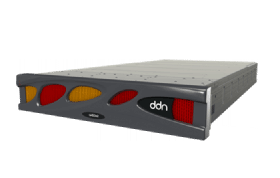
Getty Images
DDN launches high-performance AI storage with AI400X2
DataDirect Networks' AI400X2 comes with double the performance and nearly twice the capacity of its previous model, and new features for AI storage such as automatic tiering.
DataDirect Networks has expanded its line of A3I AI storage platforms, bringing twice the performance, higher capacity and new optimizations for AI storage in the same footprint as the previous model.
The AI400X2, which follows the AI400X and is an expansion of DDN's A3I line, is aimed at enterprise AI storage use cases. Its performance is more than 90 GBps and sits in a 2U footprint, doubling the AI400X's performance of 45 GBps in the same footprint, according to DDN. The new storage platform introduces features such as hot nodes, which reduce system network traffic, and hot pools, which tier data automatically within the system.
AI workloads, previously relegated to high-performance computing, are growing in the enterprise and will need storage, a trend that will only continue, said Eric Burgener, a senior analyst at IDC.
"Over the next five years, AI workloads are [going to be] the fastest-growing workload of all workloads," he said.
As AI workloads grow in the enterprise, companies are looking for ease of deployment, high availability, fast recovery and low latency, Burgener said. They would also benefit from a converged infrastructure stack, a parallel file system with prequalified hardware (accelerated compute or GPUs from Nvidia, high-performance networking from Mellanox, and high-performance storage from DDN) and software sold together by one vendor, such as the AI400X2 offered by DDN.
Optimized for AI
The AI400X2 has been built for AI workloads, mainly working with Nvidia DGX POD and SuperPOD Systems, which are AI infrastructure products and used by enterprise customers needing AI compute and storage at scale, according to DDN.

It uses the latest InfiniBand ports on the front end and NVMe PCIe Gen4 SSDs, according to Kurt Kuckein, senior vice president of marketing at DDN. With the new performance upgrades, DDN claims the AI400X2 is the fastest parallel storage on the market, with 96 GBps for read and 65 GBps for write.
The AI400X2 also includes new features such as hot pools -- automated tiering that moves cold data to HDDs, regardless of latency requirements and keeps hot data on the flash, all within a single file system, Kuckein said. Hot pools learn how files are accessed by monitoring access frequency and tiers them accordingly.
AI workloads could require the use of both hot data, such as large files needed frequently, and cold data, such as streaming-type files that perform well off HDDs, he said.
IDC's Burgener said hot pools are in line with a concept called file heat, which assigns a temperature to data based on how often it's accessed. Tiering data by temperature is more flexible compared with the older method of moving a file that needs to be accessed from the HDD to the cache, taxing compute.
Performance of the HDD tier is about 60% of the front-end performance by using a single namespace to directly access the file on the HDD, versus moving it to the hot tier or caching it, Kuckein said.
The HDD tiers are separate, dense expansion enclosures but don't require a separate host, which gives a top capacity of up to 11.5 petabytes in a 22U footprint. If customers need more capacity, several AI400X2 systems with HDD encloses can be clustered together, enabling consolidation for AI workloads, not general data center consolidation, Kuckein said.
Hot nodes
The new AI400X2 model also introduces hot nodes to the storage platform. Hot nodes use the client's GPU cache as part of DDN's ExaScaler file system on the AI400X2. This is another type of automated tiering, moving necessary data to the client's accelerated compute. The file is cached for rapid reads, which eliminates network traffic and reduces latency by keeping the file on the client storage rather than going over the network, according to Kuckein.
Currently, DDN offers hot nodes with Nvidia DGX 500 systems, but the feature is not exclusive to those systems.
Customers and availability
DDN said with the AI400X2 it is targeting enterprise customers that need to scale their performance and capacity for their AI workloads, Kuckein said.
But, Burgener said, only a certain type of customer would need a system like the AI400X2. Smaller AI workloads can operate using a distributed file system; however, once the workloads grow past a certain size, some will need a parallel scale-out file system.
DDN works tightly with Nvidia including Nvidia's SELENE system. The A3I systems are used for storage in Nvidia's DGX POD and DGX SuperPOD as well.
The AI400X2 is shipping now. DDN said it will be priced like the AI400X but provided no specifics.





